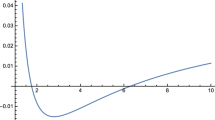Abstract
Suppose thatX 1,X 2, ... is a sequence of i.i.d. random variables taking value inZ +. Consider the random sequenceA(X)≡(X 1,X 2,...). LetY n be the number of integers which appear exactly once in the firstn terms ofA(X). We investigate the limit behavior ofY n /E[Y n ] and establish conditions under which we have almost sure convergence to 1. We also find conditions under which we dtermine the rate of growth ofE[Y n ]. These results extend earlier work by the author.
Similar content being viewed by others
References
Cuevas, Antonio, and Walters, Gilbert G. (1992). A note on estimation of generalized densities.Comm. Statist. Theory Methods 21, 1807–1821.
Eisenberg, B., Stengle, G., and Strang, G. (1993). The asymptotic probability of a tie for first place.Ann. Appl. Prob. 3, 731–745.
Key, Eric S. (1992). Rare numbers.J. Theoret. Prob. 5, 375–389.
Author information
Authors and Affiliations
Rights and permissions
About this article
Cite this article
Key, E.S. Divergence rates for the number of rare numbers. J Theor Probab 9, 413–428 (1996). https://doi.org/10.1007/BF02214657
Received:
Revised:
Issue Date:
DOI: https://doi.org/10.1007/BF02214657



